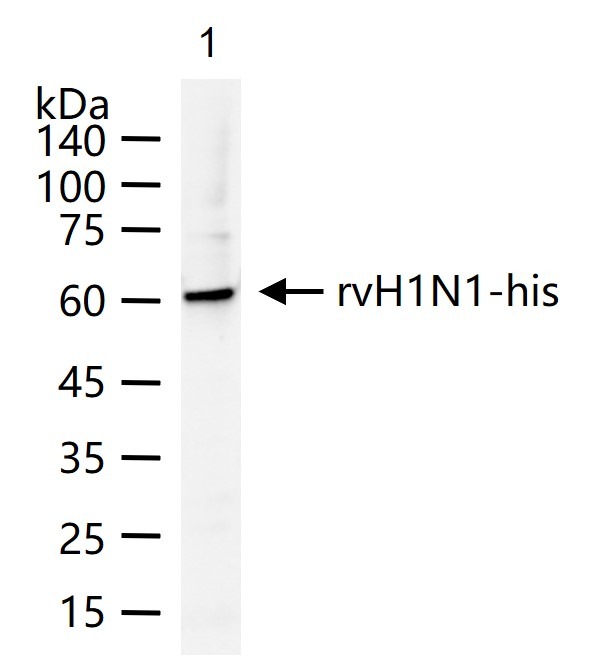Shopping Cart
- Remove All
 Your shopping cart is currently empty
Your shopping cart is currently empty
Anti-H1N1 Matrix Protein 1 Polyclonal Antibody is a Rabbit antibody targeting H1N1 Matrix Protein 1. Anti-H1N1 Matrix Protein 1 Polyclonal Antibody can be used in WB.
| Pack Size | Price | Availability | Quantity |
|---|---|---|---|
| 50 μL | $221 | 7-10 days | |
| 100 μL | $372 | 7-10 days | |
| 200 μL | $528 | 7-10 days |
| Description | Anti-H1N1 Matrix Protein 1 Polyclonal Antibody is a Rabbit antibody targeting H1N1 Matrix Protein 1. Anti-H1N1 Matrix Protein 1 Polyclonal Antibody can be used in WB. |
| Synonyms | Influenza A virus(A/California/04/2009(H1N1))Matrix Protein-1, H1N1 M1 |
| Ig Type | IgG |
| Reactivity | Influenza A virus H1N1 |
| Verified Activity | 20 ng Influenza A virus H1N1 Nucleoprotein, C-His per Lane probed with H1N1 Matrix Protein 1 polyclonal antibody respectively, unconjugated (TMAB-00824) at 1:1000 dilution and 4°C overnight incubation. Followed by corresponding conjugated secondary antibody incubation at RT for 60 min.  |
| Application | |
| Recommended Dose | WB: 1:500-2000 |
| Antibody Type | Polyclonal |
| Host Species | Rabbit |
| Subcellular Localization | Virion membrane. Host apical cell membrane; Single-pass type III membrane protein. Note=Abundantly expressed at the apical plasma membrane in infected polarized epithelial cells, in close proximity to budding and assembled virions. Minor component of virions (only 16-20 molecules/virion). |
| Construction | Polyclonal Antibody |
| Purification | Protein A purified |
| Appearance | Liquid |
| Formulation | 0.01M TBS (pH7.4) with 1% BSA, 0.02% Proclin300 and 50% Glycerol. |
| Concentration | 1 mg/mL |
| Research Background | Influenza A virus is a major public health threat. Novel influenza virus strains caused by genetic drift and viral recombination emerge periodically to which humans have little or no immunity, resulting in devastating pandemics. Influenza A can exist in a variety of animals; however it is in birds that all subtypes can be found. These subtypes are classified based on the combination of the virus coat glycoproteins hemagglutinin (HA) and neuraminidase (NA) subtypes. During 1997, an H5N1 avian influenza virus was determined to be the cause of death in 6 of 18 infected patients in Hong Kong. There was some evidence of human to human spread of this virus, but it is thought that the transmission efficiency was fairly low. HA interacts with cell surface proteins containing oligosaccharides with terminal sialyl residues. Virus isolated from a human infected with the H5N1 strain in 1997 could bind to oligosaccharides from human as well as avian sources, indicating its species jumping ability. |
| Immunogen | KLH conjugated synthetic peptide: H1N1 Matrix Protein 1 |
| Gene Name | NP |
| Protein Name | Nucleoprotein |
| Biology Area | Influenza,Viral Protein |
| Function | Forms a proton-selective ion channel that is necessary for the efficient release of the viral genome during virus entry. After attaching to the cell surface, the virion enters the cell by endocytosis. Acidification of the endosome triggers M2 ion channel activity. The influx of protons into virion interior is believed to disrupt interactions between the viral ribonucleoprotein (RNP), matrix protein 1 (M1), and lipid bilayers, thereby freeing the viral genome from interaction with viral proteins and enabling RNA segments to migrate to the host cell nucleus, where influenza virus RNA transcription and replication occur. Also plays a role in viral proteins secretory pathway. Elevates the intravesicular pH of normally acidic compartments, such as trans-Golgi network, preventing newly formed hemagglutinin from premature switching to the fusion-active conformation. |
| Molecular Weight | Theoretical: 28 kDa. |
| Stability & Storage | Store at -20°C or -80°C for 12 months. Avoid repeated freeze-thaw cycles. |
| Transport | Shipping with blue ice. |

Copyright © 2015-2025 TargetMol Chemicals Inc. All Rights Reserved.